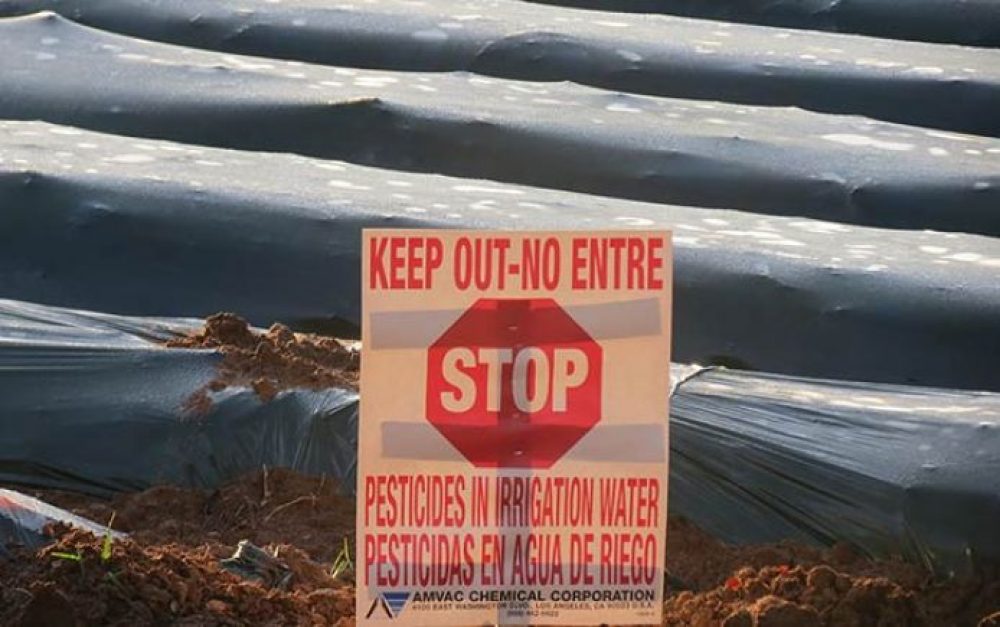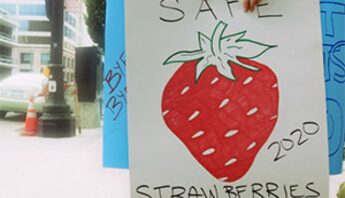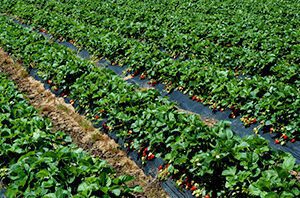Last fall PAN partnered with Justin Matlow, a concerned parent and teacher in the heart of California's strawberry-growing country, to monitor for pesticide drift. Today — to mark Cesar Chavez day — we joined Justin, farmworker advocates and other community partners to release our findings.
What do the data tell us? In short, our Drift Catcher project found that when the cancer-causing pesticide chloropicrin was being applied in a nearby field, concentrations in the air near Justin's Watsonville home were at or above levels considered "of concern" by both state and federal agencies. For the sake of thousands of California families living near strawberry fields, we hope the regulators are paying attention.
California produces more strawberries than any other state in the country, and Watsonville is at the center of one of the biggest strawberry-producing areas in the state. To grow all those strawberries using conventional methods, a whole lot of pesticides are used — and drift-prone fumigant pesticides like chloropicrin are at the top of the list.
Drift-prone & dangerous
Fumigants are both highly toxic and highly volatile (i.e., "driftable"), and are used to clear the soil of pests before planting. They can be applied in various ways. Two of the most common methods are "injection" into the soil as a gas, and soaking via drip lines — both of which take place under tarps (you'll see acres of this plastic sheeting in Watsonville and Salinas in the fall).
PAN and our partners at Californians for Pesticide Reform (CPR) have been pointing to the dangers of fumigants — and pressing for adoption of safer alternatives — for many years. These chemicals are inherently dangerous. Not only are they prone to drift when applied (if tarps rip or otherwise fail, which is not uncommon), but they also tend to "volatilize," or rise into the air the way fumes rise into the air when you're chopping an onion.
That's why Justin Matlow was concerned when he learned that farms near his home were scheduled for fumigation.
Justin teaches junior high school, and lives in a neighborhood bordered by agricultural fields on the outskirts of Watsonville. The closest farm is located about 350 feet from his home. In addition to his two young sons, there are other families in the neighborhood; Justin estimates that 12 other children ranging in age from 3-16 live in homes located along the fields. Over 30 homes are within a half-mile of the farm, and there are many other fields nearby.
Per his request, the county Agricultural Commissioner sent Justin a letter notifying him that the fumigations were scheduled for early November. Two seven-acre fields were fumigated with chloropicrin a few days apart, and it seems the applicators did everything according to regulation.
The type of application used on these particular fields is called "bedded drip," where the fumigant is applied via irrigation lines that are laid out under tarps. This method — and the particular kind of tarps used — supposedly keep fumigants from rising out of the ground at harmful levels.
The problem is, the Drift Catcher data indicate that these dangerous emissions are not, in fact, under control.
How much "excess" cancer?
According to a 2010 DPR scientific review panel, the evidence suggests that chloropicrin is "a potent carcinogen."
The results of our air sampling in Watsonville show levels of exposure to chloropicrin that translate into increased cancer risk for people in this community — and this is just from the applications on two fields at one farm. There were many more fields near the neighborhood that had tarps on them when I was out training Justin to use the Drift Catcher.
We calculated the increased cancer risk based on only nine days’ worth of exposure, since that's how long the air was monitored in this particular case. An increased probability of cancer — or "excess" cancer risk — is expressed as anything over one in a million.
Based on the level of exposures detected in this study, this particular Watsonville neighborhood would face:
9 excess cases of cancer per million among children from 0-2 years of age
16 excess cases of cancer per million among juveniles from 2-16 years of age
39 excess cancer cases per million over a lifetime of 70 years
Chloropicrin is now the most commonly used fumigant in California, with nine million pounds used every year. A 2014 report from the state Department of Public Health put this chemical at the top of the list of pesticides sprayed near California schools.
Clearly, it's not just Justin's neighborhood that's facing "excess" cases of cancer.
Immediate protections, long term solutions
California's Department of Pesticide Regulation recently proposed new, tighter rules for chloropicrin, including buffer zones and specific application methods and tarps to reduce risk of exposure. The new restrictions would include 25 to 100 foot no-fumigation buffer zones around schools and residences if special “totally impermeable film” (TIF) tarps are used.
But the data released today clearly show that the proposed new rules won't do enough to protect families in Watsonville and other strawberry-growing communities. In Justin’s case, the required buffer zone between the treated field and his home under the new rules would have been 40 feet. Yet concerning levels of chloropicrin were found from applications nearly 10 times that far away.
As Justin notes in today's press statement,
“This is a concern not only for me and my neighbors, but also for the many families across the Central Coast and the state that live near fields fumigated with chloropicrin.”
An agricultural system reliant on hazardous pesticides means that farmworkers, farmers, and agricultural communities pay a price for these exposures. The regulations protecting communities do need to change, but we also need to support farmers as they transition to methods that don't rely on fumigants.








